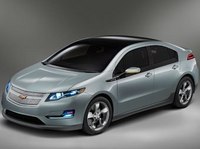GM Claims 200+ MPG City Rating for Chevrolet Volt (Electric Hybrid)
SEE ALSO: EV-MOTORING.COM
DETROIT August 11, 2009; Kevin Krolicki and Soyoung Kim writing for Reuters reported that the Chevrolet Volt -- the electric vehicle General Motors Co is counting on to recharge its image with consumers -- is on track to hit an unprecedented fuel economy rating of 230 miles per gallon in city driving, the automaker said on Tuesday.
GM Chief Executive Fritz Henderson said the Volt would get a "triple-digit" fuel economy rating for combined highway and city driving based on a draft standard developed by the U.S. Environmental Protection Agency.
"The Volt is becoming very real, very fast," Henderson said in an announcement at GM's technical center that was webcast to the public.
The Volt, which will be introduced late next year, is designed to run for 40 miles from a single charge of a lithium-ion battery pack. After the battery is partly depleted, a small combustion engine is designed to kick in to recharge the battery and power the vehicle.
In drafting standards to calculate the published mileage rating for the Volt and other upcoming electric vehicles, U.S. regulators have made assumptions about how much a typical driver will rely on the traditional gas engine.
Those standards, which will also provide a crucial benchmark under recently tightened federal fuel economy standards, are due to be published later this year.
Henderson said GM has engineers working on second and third-generation versions of the Volt in order to bring down the cost of battery-powered vehicles.
GM has been racing to make the Volt the first mass-market plug-in hybrid in the U.S. market in order to shake its association with gas-guzzling trucks and generate buzz for its car line-up that will take aim at competitors led by Toyota Motor Corp.
The Volt is designed to be recharged at a standard electric outlet. Henderson said that would reduce the cost of the first 40 miles of driving for some Americans to as little as 40 cents, the cost of recharging the car overnight in a garage.
For most vehicles, it would cost well over $3 to drive 40 miles, based on current gas prices.
Toyota has dominated the hybrid market with its Prius, now in its third generation.
The current Prius gets a fuel economy rating of 50 miles per gallon in combined city and highway driving. The Toyota hybrid accounted for over 60 percent of all U.S. hybrid sales in the first seven months of 2009.
The Japanese automaker is also developing a rechargeable version of the Prius that will compete with the Volt although the GM plug-in appears on track to be the first vehicle of its kind in U.S. showrooms.
THE COST OF SUCCESS
One of the hurdles for the Volt has been its projected sticker price, which GM executives have said could be $40,000 before accounting for a $7,500 tax credit to consumers.
GM has also acknowledged that the Volt will not be profitable in its first version because of the development costs it has incurred in its race to develop the vehicle, including its 400-pound battery pack.
"We're excited about the potential but the cost is high," said Henderson.
"In general, I don't want to say we're going to subsidize things," he said in response to a question on the Volt's pricing. "But that said, we need volumes to get to (the second generation)."
The announcement of the Volt's projected fuel economy comes a month after GM exited a fast-track bankruptcy and comes as part of an effort by Henderson to shift attention back to the company's vehicles and away from its recent financial crisis.
GM emerged from bankruptcy under the majority ownership of the U.S. Treasury. The automaker is planning an initial public offering by July 2010 to pay back part of that taxpayer funding.
Henderson said GM was on track to post a net profit as early as 2011 after slashing its costs in bankruptcy and seeing an improvement in auto sales from a slump that pushed the U.S. market to the lowest levels since the early 1980s.
U.S. auto sales rose in July as Americans rushed to take advantage of a government "Cash for Clunkers" incentive to trade in old gas guzzlers for more fuel efficient vehicles, raising hopes that the battered sector is poised for recovery.
With GM's inventory levels low, the automaker is looking at raising production in the current and coming quarter to adjust to steadier demand, Henderson said.
"We certainly feel very good about our inventory position, feel better about the market at least hitting the bottom and maybe starting to bounce, and we will adjust accordingly," he said.
(Reporting by Kevin Krolicki and Soyoung Kim; Editing by Derek Caney) Buzz up! 0 Send Share Print



